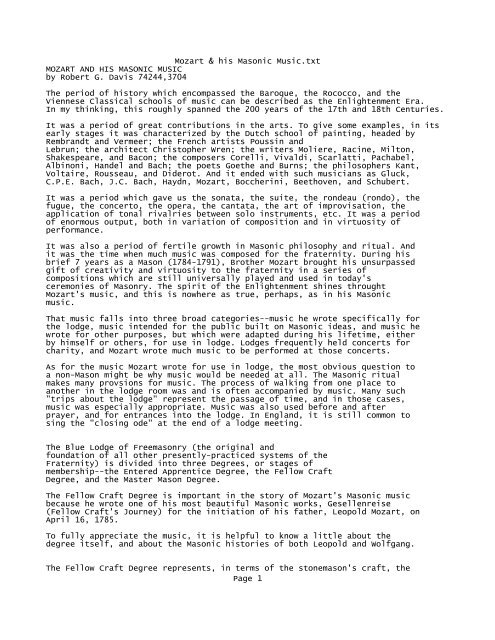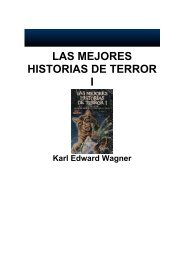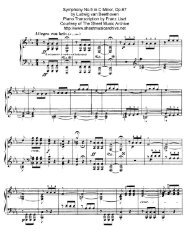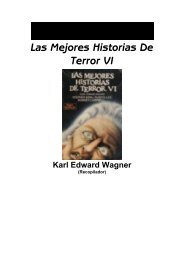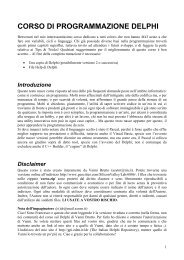Mozart & his Masonic Music.txt - Notepad - Risorse Gratuite
Mozart & his Masonic Music.txt - Notepad - Risorse Gratuite
Mozart & his Masonic Music.txt - Notepad - Risorse Gratuite
Create successful ePaper yourself
Turn your PDF publications into a flip-book with our unique Google optimized e-Paper software.
<strong>Mozart</strong> & <strong>his</strong> <strong>Masonic</strong> <strong>Music</strong>.<strong>txt</strong><br />
MOZART AND HIS MASONIC MUSIC<br />
by Robert G. Davis 74244,3704<br />
The period of <strong>his</strong>tory which encompassed the Baroque, the Rococco, and the<br />
Viennese Classical schools of music can be described as the Enlightenment Era.<br />
In my thinking, t<strong>his</strong> roughly spanned the 200 years of the 17th and 18th Centuries.<br />
It was a period of great contributions in the arts. To give some examples, in its<br />
early stages it was characterized by the Dutch school of painting, headed by<br />
Rembrandt and Vermeer; the French artists Poussin and<br />
Lebrun; the architect Christopher Wren; the writers Moliere, Racine, Milton,<br />
Shakespeare, and Bacon; the composers Corelli, Vivaldi, Scarlatti, Pachabel,<br />
Albinoni, Handel and Bach; the poets Goethe and Burns; the philosophers Kant,<br />
Voltaire, Rousseau, and Diderot. And it ended with such musicians as Gluck,<br />
C.P.E. Bach, J.C. Bach, Haydn, <strong>Mozart</strong>, Boccherini, Beethoven, and Schubert.<br />
It was a period which gave us the sonata, the suite, the rondeau (rondo), the<br />
fugue, the concerto, the opera, the cantata, the art of improvisation, the<br />
application of tonal rivalries between solo instruments, etc. It was a period<br />
of enormous output, both in variation of composition and in virtuosity of<br />
performance.<br />
It was also a period of fertile growth in <strong>Masonic</strong> philosophy and ritual. And<br />
it was the time when much music was composed for the fraternity. During <strong>his</strong><br />
brief 7 years as a Mason (1784-1791), Brother <strong>Mozart</strong> brought <strong>his</strong> unsurpassed<br />
gift of creativity and virtuosity to the fraternity in a series of<br />
compositions which are still universally played and used in today's<br />
ceremonies of Masonry. The spirit of the Enlightenment shines throught<br />
<strong>Mozart</strong>'s music, and t<strong>his</strong> is nowhere as true, perhaps, as in <strong>his</strong> <strong>Masonic</strong><br />
music.<br />
That music falls into three broad categories--music he wrote specifically for<br />
the lodge, music intended for the public built on <strong>Masonic</strong> ideas, and music he<br />
wrote for other purposes, but which were adapted during <strong>his</strong> lifetime, either<br />
by himself or others, for use in lodge. Lodges frequently held concerts for<br />
charity, and <strong>Mozart</strong> wrote much music to be performed at those concerts.<br />
As for the music <strong>Mozart</strong> wrote for use in lodge, the most obvious question to<br />
a non-Mason might be why music would be needed at all. The <strong>Masonic</strong> ritual<br />
makes many provsions for music. The process of walking from one place to<br />
another in the lodge room was and is often accompanied by music. Many such<br />
"trips about the lodge" represent the passage of time, and in those cases,<br />
music was especially appropriate. <strong>Music</strong> was also used before and after<br />
prayer, and for entrances into the lodge. In England, it is still common to<br />
sing the "closing ode" at the end of a lodge meeting.<br />
The Blue Lodge of Freemasonry (the original and<br />
foundation of all other presently-practiced systems of the<br />
Fraternity) is divided into three Degrees, or stages of<br />
membership--the Entered Apprentice Degree, the Fellow Craft<br />
Degree, and the Master Mason Degree.<br />
The Fellow Craft Degree is important in the story of <strong>Mozart</strong>'s <strong>Masonic</strong> music<br />
because he wrote one of <strong>his</strong> most beautiful <strong>Masonic</strong> works, Gesellenreise<br />
(Fellow Craft's Journey) for the initiation of <strong>his</strong> father, Leopold <strong>Mozart</strong>, on<br />
April 16, 1785.<br />
To fully appreciate the music, it is helpful to know a little about the<br />
degree itself, and about the <strong>Masonic</strong> <strong>his</strong>tories of both Leopold and Wolfgang.<br />
The Fellow Craft Degree represents, in terms of the stonemason's craft, the<br />
Page 1
<strong>Mozart</strong> & <strong>his</strong> <strong>Masonic</strong> <strong>Music</strong>.<strong>txt</strong><br />
status of Journeyman. In terms of Freemasonry, it represents manhood in its<br />
full vigor and strength, as the first Degree represents youth and the third<br />
Degree represents the wisdom and maturity of age.<br />
The ritual of the Fellow Craft Degree takes classical education as one of its<br />
strongest symbols. The Mason receiving the Degree is reminded of the five<br />
classic Orders of Architecture, as well as the seven Liberal Arts and<br />
Sciences--Grammar, Rhetoric, Logic, Arithmetic, Geometry, <strong>Music</strong> and<br />
Astronomy.<br />
The instruction in the ritual takes the form of the<br />
ascent of winding stairs, with each step representing a new<br />
acquisition of knowledge and insight. That ascent is the<br />
Fellow Craft's journey.<br />
It symbolizes more than mere instruction, however. The journey is the journey<br />
of life, which at t<strong>his</strong> stage is a preparation for productive living as a<br />
spiritual being. Its purpose is to help awaken the individual to <strong>his</strong> life not<br />
just as an intelligent animal but as a mind--free and untrammeled--and as a<br />
spirit, bound to all humanity by the Fatherhood of God. The lyrics selected<br />
by <strong>Mozart</strong> for Gesellenreise include:<br />
You, who now are risen higher<br />
Unto Wisdom's high abode,<br />
Wander steadfast higher, higher<br />
Know, it is the noblest road.<br />
Only spirit without blight<br />
May approach the source of Light.<br />
Even in t<strong>his</strong> short passage, you can see the elements of the Enlightenment and<br />
of Masonry--the idea that both life and initiation was a journey of stages,<br />
the idea of Light, and of drawing nearer to it. The search for wisdom and<br />
understanding.<br />
In the introduction to <strong>his</strong> book <strong>Mozart</strong> and Masonry Paul Nettl writes,<br />
". . . there is a <strong>Masonic</strong> secret, a mystery, an experience<br />
that cannot be taught or explained because it lies, like<br />
every mystic experience, beyond the realm of controlled<br />
consciousness. At its deepest level it is identical with<br />
intense feeling and empathy. The secret of Freemasonry is<br />
the secret of experiencing true love for all mankind, a<br />
positive attitude towards man and life, and broad<br />
affirmation of God. It is the realization that beyond the<br />
dark and material world there is a realm of light towards<br />
which all men must strive."<br />
It is t<strong>his</strong> journey, t<strong>his</strong> secret, which <strong>Mozart</strong><br />
celebrated in music for <strong>his</strong> father.<br />
Wolfgang <strong>Mozart</strong> was apparently sponsored in <strong>his</strong> petition to join Masonry by<br />
the Baron Otto Freiherr von Gemmingen-Hornberg, Master of Zur Wohltataigkeit<br />
(Charity) Lodge. <strong>Mozart</strong> had met Gemmingen in Mannheim. His name was put<br />
before the Lodge on December 5, 1784, and he appears to have received the<br />
Entered Apprentice Degree on December 14. On January 7, 1785, he re ceived<br />
the Fellow Craft Degree at<br />
"Zur wahren Eintracht" (True Harmony) Lodge at the request of <strong>his</strong> home Lodge.<br />
On April 22, he received the Master Mason Degree.<br />
But Jacques Chailley, in The Magic Flute Unveiled: Esoteric<br />
Symbolism in <strong>Mozart</strong>'s <strong>Masonic</strong> Opera, points out that<br />
<strong>Mozart</strong>'s association with Freemasonry long predated <strong>his</strong><br />
petition to the Fraternity. At the age of 11, <strong>Mozart</strong> set the<br />
<strong>Masonic</strong> poem An die Freude to music and sent it as a gift to<br />
Dr. Joseph Wolf who had treated him for smallpox. At 16, he<br />
Page 2
<strong>Mozart</strong> & <strong>his</strong> <strong>Masonic</strong> <strong>Music</strong>.<strong>txt</strong><br />
composed an aria on the words of the ritual hymn O heiliges<br />
Band. At 17, he was selected by Gebler to compose the<br />
incidental music for the <strong>Masonic</strong> drama Thamos (which he<br />
revised in 1779).<br />
Leopold <strong>Mozart</strong>, it was announced in Wolfgang's Lodge on March 28, 1785, had<br />
been proposed for membership. As Leopold was about to leave the city, a<br />
dispensation to proceed more rapidly than usual was sought and obtained. On<br />
April 6, he was initiated as an Entered Apprentice. On April 16, he was<br />
passed to the Degree of Fellow Craft, with Wolfgang in attendance. On April<br />
22, Leopold became a Master Mason. Two days later, father and son attended<br />
the Lodge Zur gerkronten Hoffnung to honor the Lodge's Master, Ignaz Born.<br />
Wolfgang composed a new cantata for the occasion (K.471). The day after the<br />
concert, Leopold left for Salzburg. His son was never to see him again.<br />
<strong>Mozart</strong>'s <strong>Masonic</strong> <strong>Music</strong> is rich and varied, but any listing is subject to<br />
criticism. The simple reason is that music played a very important part in<br />
Masonry. <strong>Music</strong> was used in the Degrees, performed at refreshment as<br />
entertainment (which would have been an experience--<strong>Mozart</strong>'s Lodge contained<br />
some of the finest performers in Europe, and we know from minutes of the<br />
Lodge meetings that they often sat around after Lodge had formally closed and<br />
improvised into the small hours ofthe morning) and at special public<br />
concerts, frequently given by the Lodges for charitable purposes. So we have<br />
<strong>Masonic</strong> ritual music, music written for or adapted for entertainment at<br />
<strong>Masonic</strong> functions, and music on <strong>Masonic</strong> themes, not intended for performance<br />
in Lodge, some of which as we have seen, was written before he joined the<br />
fraternity. The following listing (based on the work of Charles Tupper)<br />
contains elements of all these, with notes showing their <strong>Masonic</strong> relevance.<br />
Lied: An die Freude, K.53 (setting of a <strong>Masonic</strong> text)<br />
Psalm 129: De Profundis Clamavi for mixed choir and orchestra K.93 (composed<br />
in Salzburg in 1771 and later adapted to Freemasonic work by the composer)<br />
Lied: O heiliges Band der Freudschaft for tenor and Piano K.148 (composed in<br />
1772 and adopted for Masonry; probably sung at refreshment)<br />
Graduale ad Festum B.M.V.: "Sancta Maria, mater Die for mixed choir and<br />
orchestra K.273 (composed in 1777, it<br />
was immediately added to the musical canon of the Lodge)<br />
Incidental <strong>Music</strong>: Thamos Konig in Agypten, K.345 (incidental music for a<br />
play, the themes are heavily <strong>Masonic</strong> - considered a forerunner of The Magic<br />
Flute)<br />
Canonic Adagio for 2 bassett Horns and Bassoon, K.410 (composed in 1784,<br />
ritual procession music)<br />
Adagio for 2 Clarinets and 3 Bassett Horns, K.411 (probably intended as a<br />
processional entrance for the Lodge)<br />
Cantata: "Dir, Seele des Weltalls," K.429 (composed for a public <strong>Masonic</strong><br />
celebration)<br />
Gesellenreise: "Die ihr einem neuen Grade," K.468 (composed for <strong>his</strong> father's<br />
Fellow Craft Degree)<br />
Cantata: Die Maurerfreude "Sehen wie dem starren Forscherauge," K.471<br />
(composed in April, 1785, to honor Ignaz von Born, Grand Master of the United<br />
Lodges)<br />
[According to the records of the Lodge, <strong>Mozart</strong> wrote the music for two<br />
Page 3
<strong>Mozart</strong> & <strong>his</strong> <strong>Masonic</strong> <strong>Music</strong>.<strong>txt</strong><br />
additional songs during 1785--Des Todes Werk and Vollbracht ist die Arbeit<br />
der Meister (The Work of Death and The Work of the Masters is<br />
Finished)--which have been lost]<br />
Maurerissche Trauermusik (<strong>Masonic</strong> Funeral <strong>Music</strong>) K.477 (written for the<br />
memorial services commemorating the deaths of <strong>Mozart</strong>'s brother Masons Duke<br />
George August of Mecklenburg-Strelitz and Count Franz Veith Edler von<br />
Galantha in November, 1785, and performed in a Lodge of Sorrows)<br />
Piano Concerto in Eb Major, K.482 (written for and performed at a concert<br />
given by the Lodge Zur gekronten Hoffnung, December 15, 1785)<br />
Song: Zerfliesset Heut, Geliebte Bruder," K.483 (written to<br />
welcome newly-formed Lodges)<br />
Song: "Ihr unsre neuen Leiter," K.484 (written to welcome the newly elected<br />
Grand Master of the United Lodges)<br />
Symphony #39 in Eb, K.543 (written as a celebration of the Craft and the joy<br />
of living {see Alfred Einstein's notes on the <strong>Masonic</strong> significance of the<br />
work})<br />
Adagio and Fugue in C Minor, K.546 (not originally written for the <strong>Masonic</strong><br />
canon, it was quickly adopted by the Lodges)<br />
Adagio and Rondo for Flute, Oboe, Viola, Cello, and Celesta, K.617 (written<br />
while <strong>Mozart</strong> was working on The Magic Flute and performed at refreshment in<br />
Lodge)<br />
Motet: Ave Verum Corpus, K.618 (originally written<br />
for Anton Stoll's choir school at Baden, the work was<br />
quickly adopted for Lodge use)<br />
Cantata: "Die ihr des unermesslichen Weltalls Schopfer ehrt," K.619 (during<br />
<strong>Mozart</strong>'s last year, he paused during composition of The Magic Flute, La<br />
Clemenza di Tito and the Requiem to compose t<strong>his</strong> piece at the request of <strong>his</strong><br />
Lodge.)<br />
Cantata: "Kleine Freimaurerkantate" (little <strong>Masonic</strong> cantata) K.623 (written<br />
for the dedication of the Lodge Zur neugekronten Hoffnung)<br />
Chorus: "Lasst uns mit geschlungen Handen" K.623b (written as part of the<br />
same dedication service as above)<br />
Opera: "Die Zauberflote" (The Magic Flute) K.620<br />
<strong>Mozart</strong> died at fifty-five minutes past midnight, on December 5, 1791. The<br />
Masons held a Lodge of Sorrows in <strong>his</strong> memory, and the oration there delivered<br />
was printed by Ignez Alberti, a member of <strong>Mozart</strong>'s own Lodge, who had<br />
published the first libretto of Die Zauberflote.<br />
--<br />
For more information on <strong>Mozart</strong> and Masonry, see:<br />
Paul Nettl, <strong>Mozart</strong> and Masonry, reprinted 1987 by Dorset Press<br />
Spike Hughes, Famous <strong>Mozart</strong> Operas, Dover Publications, 1972 Joachim Kaiser,<br />
Who's Who in <strong>Mozart</strong>'s Operas: From Alfonso to Zerlina, Schirmer Books, 1987<br />
Jacques Chailley, The Magic Flute Unveiled: Esoteric Symbolism in <strong>Mozart</strong>'s<br />
<strong>Masonic</strong> Opera, Alfred A. Knopf, Inc., 1971<br />
H.C. Robbins Landon, <strong>Mozart</strong> and the Masons, Thames and Hudson,<br />
1991<br />
Page 4


